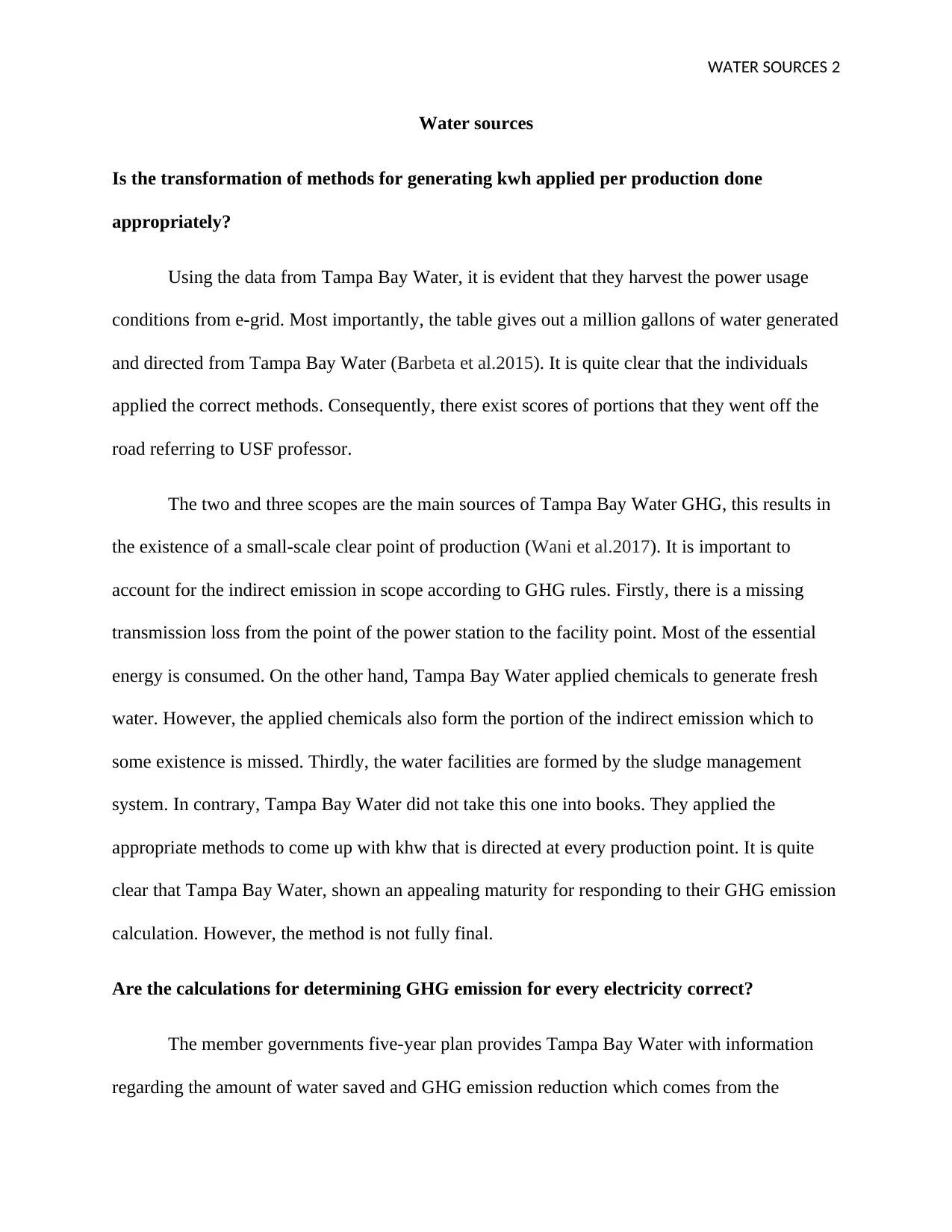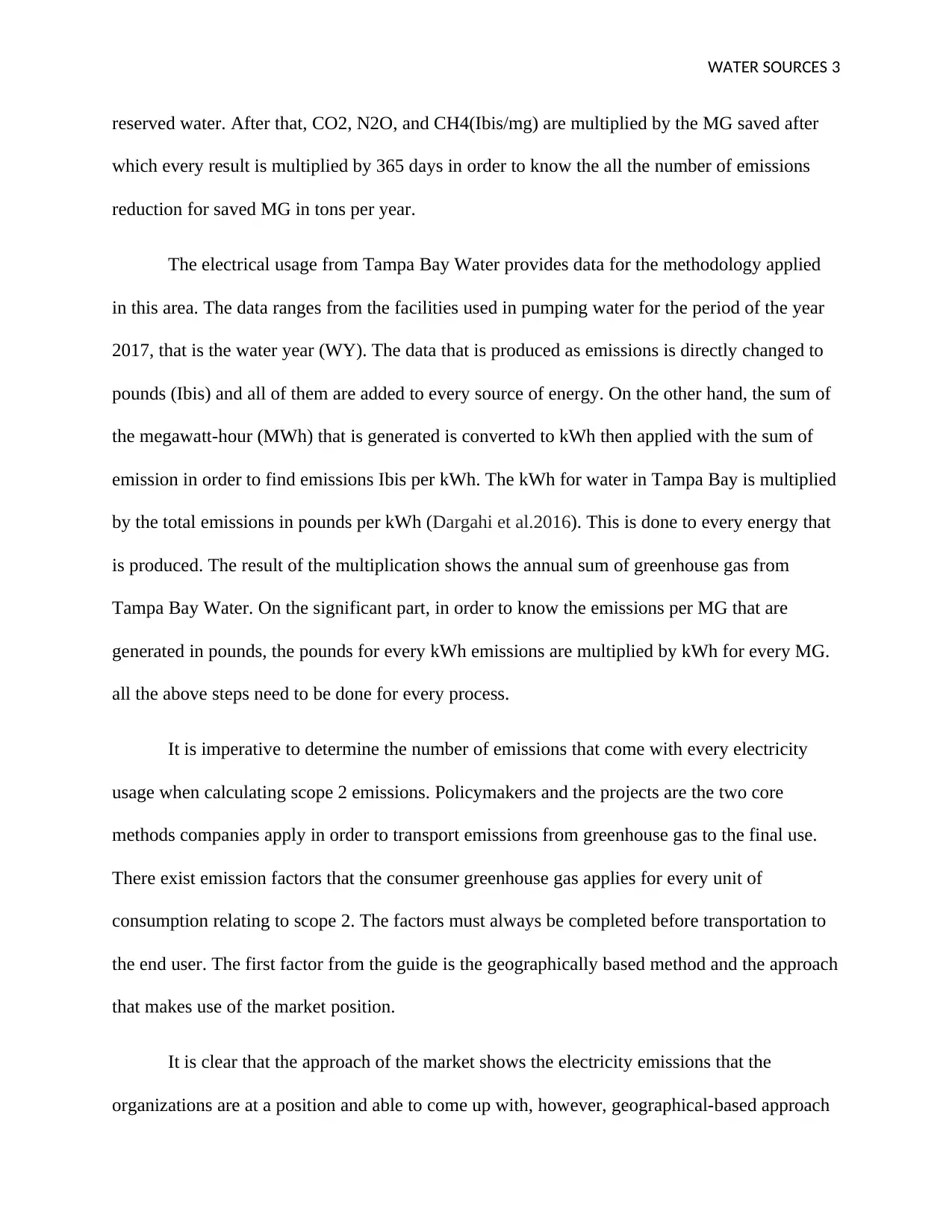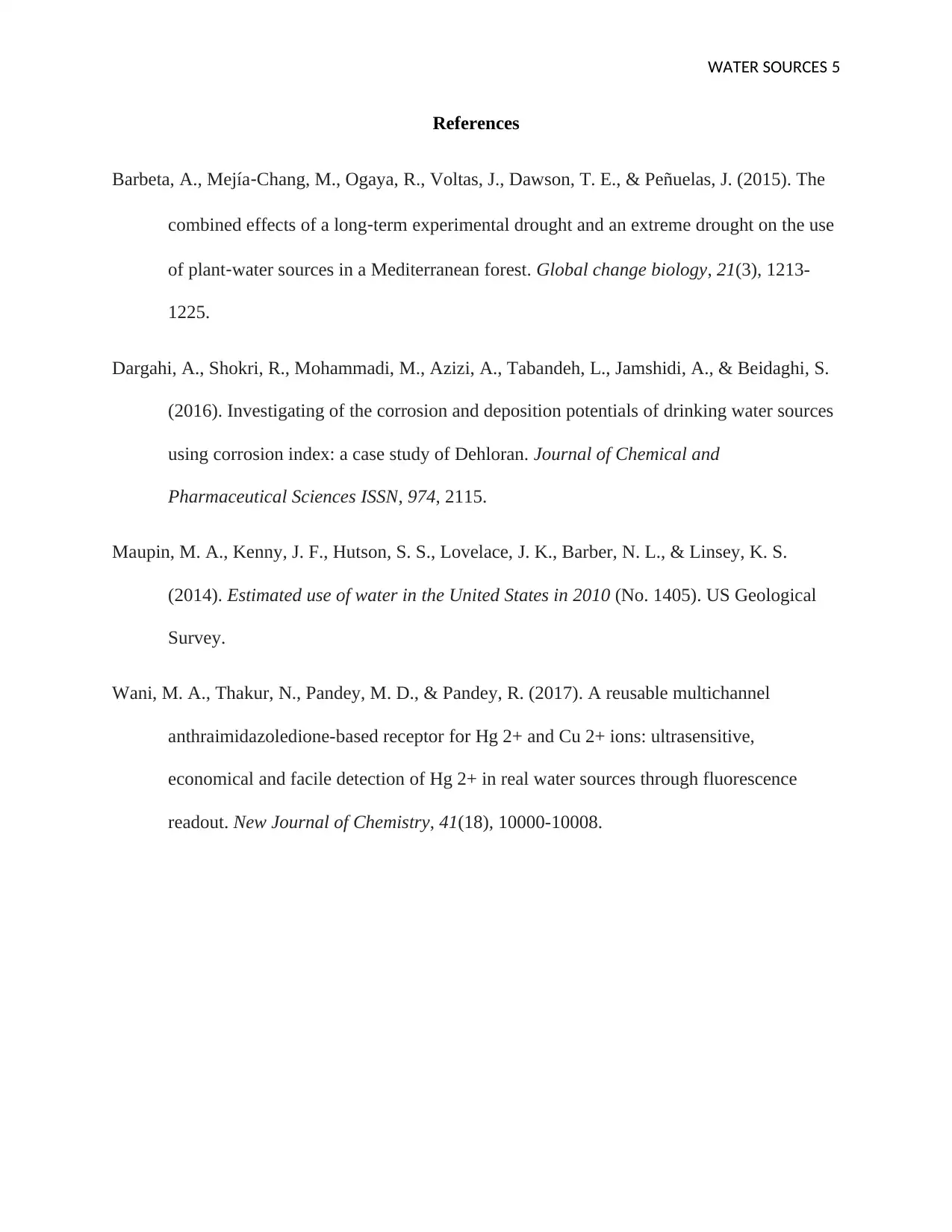Report on Tampa Bay Water: Water Sources and GHG Emission Analysis
VerifiedAdded on 2023/06/11
|5
|1026
|409
Report
AI Summary
This report analyzes Tampa Bay Water's methods for generating kWh and their approach to GHG emission calculations. It highlights the correct methods used while also pointing out areas of improvement, such as accounting for transmission loss, chemical usage, and sludge management in GHG emission calculations. The report evaluates the accuracy of GHG emission calculations for electricity, detailing the steps taken by Tampa Bay Water and the emission factors used. It also discusses the importance of determining emissions from electricity usage when calculating scope 2 emissions, contrasting geographically based and market-based approaches. The analysis concludes that while Tampa Bay Water demonstrates maturity in responding to GHG emission calculations, their methods are not yet fully finalized. Desklib provides access to similar reports and solved assignments for students.

Running head: WATER SOURCES 1
Water sources
Name
Date
Unit
lecturer
Water sources
Name
Date
Unit
lecturer
Paraphrase This Document
Need a fresh take? Get an instant paraphrase of this document with our AI Paraphraser

WATER SOURCES 2
Water sources
Is the transformation of methods for generating kwh applied per production done
appropriately?
Using the data from Tampa Bay Water, it is evident that they harvest the power usage
conditions from e-grid. Most importantly, the table gives out a million gallons of water generated
and directed from Tampa Bay Water (Barbeta et al.2015). It is quite clear that the individuals
applied the correct methods. Consequently, there exist scores of portions that they went off the
road referring to USF professor.
The two and three scopes are the main sources of Tampa Bay Water GHG, this results in
the existence of a small-scale clear point of production (Wani et al.2017). It is important to
account for the indirect emission in scope according to GHG rules. Firstly, there is a missing
transmission loss from the point of the power station to the facility point. Most of the essential
energy is consumed. On the other hand, Tampa Bay Water applied chemicals to generate fresh
water. However, the applied chemicals also form the portion of the indirect emission which to
some existence is missed. Thirdly, the water facilities are formed by the sludge management
system. In contrary, Tampa Bay Water did not take this one into books. They applied the
appropriate methods to come up with khw that is directed at every production point. It is quite
clear that Tampa Bay Water, shown an appealing maturity for responding to their GHG emission
calculation. However, the method is not fully final.
Are the calculations for determining GHG emission for every electricity correct?
The member governments five-year plan provides Tampa Bay Water with information
regarding the amount of water saved and GHG emission reduction which comes from the
Water sources
Is the transformation of methods for generating kwh applied per production done
appropriately?
Using the data from Tampa Bay Water, it is evident that they harvest the power usage
conditions from e-grid. Most importantly, the table gives out a million gallons of water generated
and directed from Tampa Bay Water (Barbeta et al.2015). It is quite clear that the individuals
applied the correct methods. Consequently, there exist scores of portions that they went off the
road referring to USF professor.
The two and three scopes are the main sources of Tampa Bay Water GHG, this results in
the existence of a small-scale clear point of production (Wani et al.2017). It is important to
account for the indirect emission in scope according to GHG rules. Firstly, there is a missing
transmission loss from the point of the power station to the facility point. Most of the essential
energy is consumed. On the other hand, Tampa Bay Water applied chemicals to generate fresh
water. However, the applied chemicals also form the portion of the indirect emission which to
some existence is missed. Thirdly, the water facilities are formed by the sludge management
system. In contrary, Tampa Bay Water did not take this one into books. They applied the
appropriate methods to come up with khw that is directed at every production point. It is quite
clear that Tampa Bay Water, shown an appealing maturity for responding to their GHG emission
calculation. However, the method is not fully final.
Are the calculations for determining GHG emission for every electricity correct?
The member governments five-year plan provides Tampa Bay Water with information
regarding the amount of water saved and GHG emission reduction which comes from the

WATER SOURCES 3
reserved water. After that, CO2, N2O, and CH4(Ibis/mg) are multiplied by the MG saved after
which every result is multiplied by 365 days in order to know the all the number of emissions
reduction for saved MG in tons per year.
The electrical usage from Tampa Bay Water provides data for the methodology applied
in this area. The data ranges from the facilities used in pumping water for the period of the year
2017, that is the water year (WY). The data that is produced as emissions is directly changed to
pounds (Ibis) and all of them are added to every source of energy. On the other hand, the sum of
the megawatt-hour (MWh) that is generated is converted to kWh then applied with the sum of
emission in order to find emissions Ibis per kWh. The kWh for water in Tampa Bay is multiplied
by the total emissions in pounds per kWh (Dargahi et al.2016). This is done to every energy that
is produced. The result of the multiplication shows the annual sum of greenhouse gas from
Tampa Bay Water. On the significant part, in order to know the emissions per MG that are
generated in pounds, the pounds for every kWh emissions are multiplied by kWh for every MG.
all the above steps need to be done for every process.
It is imperative to determine the number of emissions that come with every electricity
usage when calculating scope 2 emissions. Policymakers and the projects are the two core
methods companies apply in order to transport emissions from greenhouse gas to the final use.
There exist emission factors that the consumer greenhouse gas applies for every unit of
consumption relating to scope 2. The factors must always be completed before transportation to
the end user. The first factor from the guide is the geographically based method and the approach
that makes use of the market position.
It is clear that the approach of the market shows the electricity emissions that the
organizations are at a position and able to come up with, however, geographical-based approach
reserved water. After that, CO2, N2O, and CH4(Ibis/mg) are multiplied by the MG saved after
which every result is multiplied by 365 days in order to know the all the number of emissions
reduction for saved MG in tons per year.
The electrical usage from Tampa Bay Water provides data for the methodology applied
in this area. The data ranges from the facilities used in pumping water for the period of the year
2017, that is the water year (WY). The data that is produced as emissions is directly changed to
pounds (Ibis) and all of them are added to every source of energy. On the other hand, the sum of
the megawatt-hour (MWh) that is generated is converted to kWh then applied with the sum of
emission in order to find emissions Ibis per kWh. The kWh for water in Tampa Bay is multiplied
by the total emissions in pounds per kWh (Dargahi et al.2016). This is done to every energy that
is produced. The result of the multiplication shows the annual sum of greenhouse gas from
Tampa Bay Water. On the significant part, in order to know the emissions per MG that are
generated in pounds, the pounds for every kWh emissions are multiplied by kWh for every MG.
all the above steps need to be done for every process.
It is imperative to determine the number of emissions that come with every electricity
usage when calculating scope 2 emissions. Policymakers and the projects are the two core
methods companies apply in order to transport emissions from greenhouse gas to the final use.
There exist emission factors that the consumer greenhouse gas applies for every unit of
consumption relating to scope 2. The factors must always be completed before transportation to
the end user. The first factor from the guide is the geographically based method and the approach
that makes use of the market position.
It is clear that the approach of the market shows the electricity emissions that the
organizations are at a position and able to come up with, however, geographical-based approach
⊘ This is a preview!⊘
Do you want full access?
Subscribe today to unlock all pages.

Trusted by 1+ million students worldwide

WATER SOURCES 4
shows the average intensity of the emissions from the power table which takes in energy.
Consequently, the geographically based approach can be used in any place (Maupin et
al.2014). It clearly shows the relationship between the collective consumer demand for electricity
and the emissions from the locally based power production point.
shows the average intensity of the emissions from the power table which takes in energy.
Consequently, the geographically based approach can be used in any place (Maupin et
al.2014). It clearly shows the relationship between the collective consumer demand for electricity
and the emissions from the locally based power production point.
Paraphrase This Document
Need a fresh take? Get an instant paraphrase of this document with our AI Paraphraser

WATER SOURCES 5
References
Barbeta, A., Mejía‐Chang, M., Ogaya, R., Voltas, J., Dawson, T. E., & Peñuelas, J. (2015). The
combined effects of a long‐term experimental drought and an extreme drought on the use
of plant‐water sources in a Mediterranean forest. Global change biology, 21(3), 1213-
1225.
Dargahi, A., Shokri, R., Mohammadi, M., Azizi, A., Tabandeh, L., Jamshidi, A., & Beidaghi, S.
(2016). Investigating of the corrosion and deposition potentials of drinking water sources
using corrosion index: a case study of Dehloran. Journal of Chemical and
Pharmaceutical Sciences ISSN, 974, 2115.
Maupin, M. A., Kenny, J. F., Hutson, S. S., Lovelace, J. K., Barber, N. L., & Linsey, K. S.
(2014). Estimated use of water in the United States in 2010 (No. 1405). US Geological
Survey.
Wani, M. A., Thakur, N., Pandey, M. D., & Pandey, R. (2017). A reusable multichannel
anthraimidazoledione-based receptor for Hg 2+ and Cu 2+ ions: ultrasensitive,
economical and facile detection of Hg 2+ in real water sources through fluorescence
readout. New Journal of Chemistry, 41(18), 10000-10008.
References
Barbeta, A., Mejía‐Chang, M., Ogaya, R., Voltas, J., Dawson, T. E., & Peñuelas, J. (2015). The
combined effects of a long‐term experimental drought and an extreme drought on the use
of plant‐water sources in a Mediterranean forest. Global change biology, 21(3), 1213-
1225.
Dargahi, A., Shokri, R., Mohammadi, M., Azizi, A., Tabandeh, L., Jamshidi, A., & Beidaghi, S.
(2016). Investigating of the corrosion and deposition potentials of drinking water sources
using corrosion index: a case study of Dehloran. Journal of Chemical and
Pharmaceutical Sciences ISSN, 974, 2115.
Maupin, M. A., Kenny, J. F., Hutson, S. S., Lovelace, J. K., Barber, N. L., & Linsey, K. S.
(2014). Estimated use of water in the United States in 2010 (No. 1405). US Geological
Survey.
Wani, M. A., Thakur, N., Pandey, M. D., & Pandey, R. (2017). A reusable multichannel
anthraimidazoledione-based receptor for Hg 2+ and Cu 2+ ions: ultrasensitive,
economical and facile detection of Hg 2+ in real water sources through fluorescence
readout. New Journal of Chemistry, 41(18), 10000-10008.
1 out of 5
Your All-in-One AI-Powered Toolkit for Academic Success.
+13062052269
info@desklib.com
Available 24*7 on WhatsApp / Email
![[object Object]](/_next/static/media/star-bottom.7253800d.svg)
Unlock your academic potential
Copyright © 2020–2025 A2Z Services. All Rights Reserved. Developed and managed by ZUCOL.

